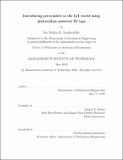Introducing perovskites to the IoT world using photovoltaic-powered ID tags
Author(s)
Kantareddy, Sai Nithin R.
Download1204264014-MIT.pdf (9.645Mb)
Other Contributors
Massachusetts Institute of Technology. Department of Mechanical Engineering.
Advisor
Sanjay E. Sarma.
Terms of use
Metadata
Show full item recordAbstract
Billions of everyday objects could benefit from being augmented with sensors and wireless data transmitters. The prospect of developing advanced battery-powered sensors and smart devices with on-board radio and computing power has been a recent research direction for the Internet of Things (IoT). IoT devices enable us to build powerful data-driven applications by acquiring rich environmental information about an object. Often these devices are powered by batteries or direct power to run the electronics and transmit the information. Battery-powered devices are expensive and require frequent battery replacements resulting in higher maintenance costs that limit their pervasive implementation. Demand for low-cost wireless connectivity presents a huge potential to use passive sensors to augment everyday objects. Passive sensors based on Radio Frequency Identification (RFID) provide an inexpensive, scalable and energy efficient way to gather environmental information. However, traditional passive tags are restricted in functionality to due to the limited RF energy available from an RFID reader. In this thesis, I show how traditional passive RFID tags can be enhanced by providing extra power with low-cost, high performance perovskite photovoltaic energy harvesters. I divide the work into three segments. First, I determine the power required for RFID tags and the current constraints on the communication range. Second, I explore perovskite photovoltaics for powering up passive tags to improve the communication range, and to provide onboard power for external sensors. I explore the tunability of perovskite photovoltaic materials to improve their indoor performance as well as create mechanically flexible energy harvesters. Third, I investigate how having additional sensors on RFID tags powered by low-cost energy harvesters can enable new IoT applications in a variety of areas. The main objectives of this thesis are: 1. Investigate passive tag power consumption with respect to different operating conditions 2. Investigate the current constraints on communication range in RFID tags and identify the limitations in real-world implementation 3. Investigate the performance and tunability of perovskite photovoltaics and their integration with the RFID tags 4. Explore industrial applications where the perovskite photovoltaic-powered tags are useful.
Description
Thesis: Ph. D., Massachusetts Institute of Technology, Department of Mechanical Engineering, 2020 Cataloged from student-submitted PDF of thesis. Includes bibliographical references (pages 85-97).
Date issued
2020Department
Massachusetts Institute of Technology. Department of Mechanical EngineeringPublisher
Massachusetts Institute of Technology
Keywords
Mechanical Engineering.